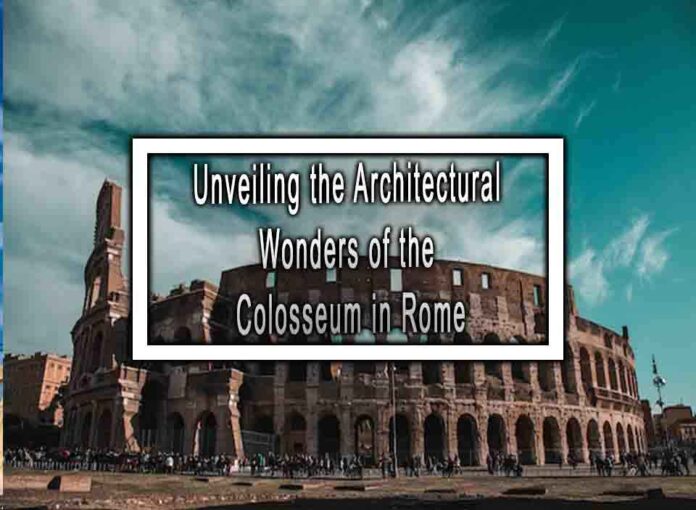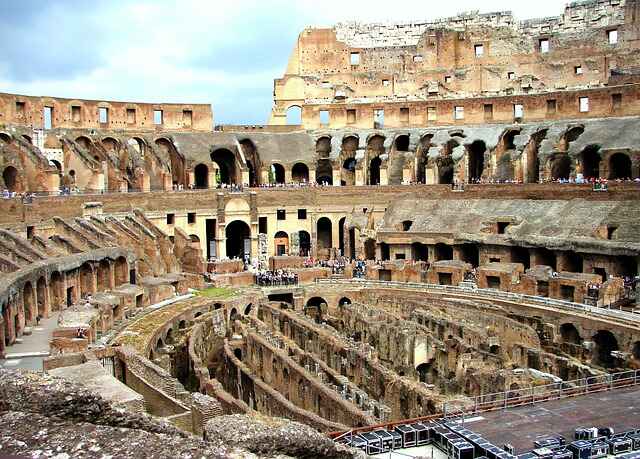The Colosseum, also known as the Flavian Amphitheatre, is one of the most iconic and enduring architectural wonders of ancient Rome. Located in the heart of Rome, Italy, this colossal amphitheater has a rich history and remains a symbol of Roman engineering and culture. Here’s an exploration of the architectural marvel that is the Colosseum:
History and Construction:
- Ancient Rome: The construction of the Colosseum began in AD 70-72 under the emperor Vespasian and was completed in AD 80-81 during the reign of his son Titus. It was part of a series of monumental building projects designed to showcase Roman power and engineering prowess.
- Purpose: The Colosseum was primarily used for hosting gladiatorial contests and various public spectacles, including animal hunts, mock sea battles, and dramas. It could hold an estimated 50,000 to 80,000 spectators.
 Architecture and Design: The Colosseum is an elliptical structure with a length of 615 feet (187 meters), a width of 510 feet (155 meters), and a height of 157 feet (48 meters). It consists of four stories with distinctive architectural features on each level.
Architecture and Design: The Colosseum is an elliptical structure with a length of 615 feet (187 meters), a width of 510 feet (155 meters), and a height of 157 feet (48 meters). It consists of four stories with distinctive architectural features on each level.
Architectural Features:
- Exterior Facade: The outer facade of the Colosseum is made of travertine limestone, a locally sourced stone. It features arches and columns in the Doric, Ionic, and Corinthian orders, each on a different level, adding to its visual appeal.
- Arches and Entrances: The Colosseum has 80 arched entrances that allowed for efficient entry and exit of large crowds. The entrances were numbered for easy navigation.
- Hypogeum: Beneath the arena floor was the hypogeum, a complex system of tunnels and chambers used to house gladiators, animals, and equipment. It had trapdoors and lifts to facilitate the spectacle’s logistics.
- Seating: The seating arrangement was divided into tiers, with the lowest tier reserved for the elite, such as senators and emperors. The upper tiers were for the general populace, with different sections designated for various social classes.
- Velarium: A retractable awning called the velarium covered the top of the Colosseum to provide shade to the spectators. It was operated using a system of ropes and poles.
Iconic Status:
- Symbol of Rome: The Colosseum is an enduring symbol of the Roman Empire’s grandeur and innovation in architecture and engineering.
- Cultural Significance: It has left an indelible mark on popular culture and has been featured in numerous films, books, and works of art.
Conservation and Tourism:
- Preservation: Ongoing preservation efforts ensure the Colosseum remains structurally sound and open to visitors. Parts of the exterior have been restored to give visitors a sense of its original splendor.
- Tourist Attraction: Today, the Colosseum is one of the most visited tourist attractions in the world as lot of people are buying pantheon tickets these days, drawing millions of visitors annually who come to explore its history, architecture, and the stories of the ancient spectacles that took place within its walls.
The Colosseum stands as a testament to the architectural and engineering achievements of ancient Rome, as well as the cultural significance of its events. It continues to inspire awe and admiration as a timeless symbol of human ingenuity and artistic expression.



 Architecture and Design: The Colosseum is an
Architecture and Design: The Colosseum is an 






